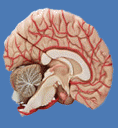Stroke

 Alternative names: Cerebrovascular disease; CVA; Cerebral infarction; Cerebral hemorrhage; Ischemic stroke; Stroke – ischemic
Alternative names: Cerebrovascular disease; CVA; Cerebral infarction; Cerebral hemorrhage; Ischemic stroke; Stroke – ischemic
Definition: A stroke is an interruption of the blood supply to any part of the brain. A stroke is sometimes called a “brain attack.”
Every 45 seconds, someone in the United States has a stroke. A stroke can happen when:
- A blood vessel carrying blood to the brain is blocked by a blood clot. This is called an ischemic stroke.
- A blood vessel breaks open, causing blood to leak into the brain. This is a hemorrhagic stroke.
Usually, a SUDDEN development of one or more of the following indicates a stroke:
- Weakness or paralysis of an arm, leg, side of the face, or any part of the body
- Numbness, tingling, decreased sensation
- Vision changes
- Slurred speech, inability to speak or understand speech, difficulty reading or writing
- Swallowing difficulties or drooling
- Loss of memory
- Vertigo (spinning sensation)
- Loss of balance or coordination
- Personality changes
- Mood changes (depression, apathy)
- Drowsiness, lethargy, or loss of consciousness
- Uncontrollable eye movements or eyelid drooping
If one or more of these symptoms is present for less than 24 hours, it may be a transient ischemic attack (TIA). A TIA is a temporary loss of brain function and a warning sign for a possible future stroke.
A stroke is a medical emergency. You must call 911 if someone has symptoms of a stroke
The goal of long-term treatment is to recover as much function as possible and prevent future strokes. Neurologist will examine you and order special tests to determine the cause of stroke and initiate appropriate treatment.

